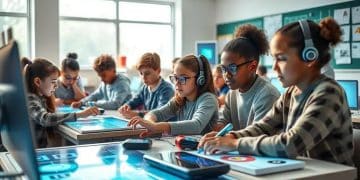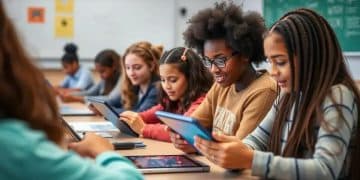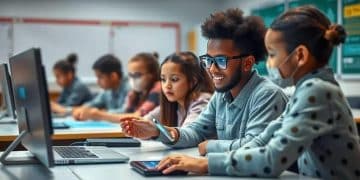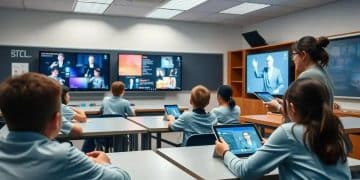Virtual reality classrooms transform the learning experience
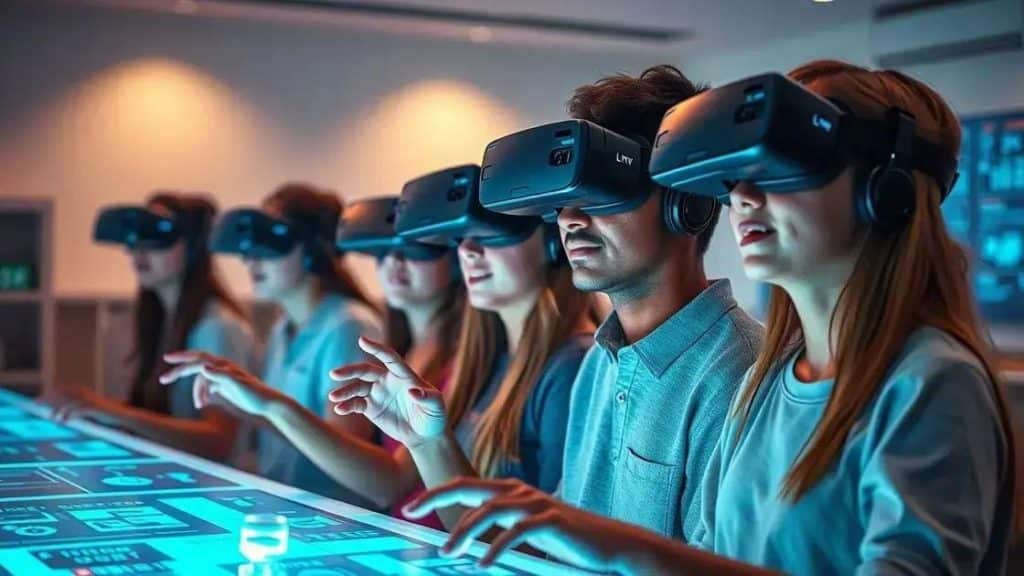
Virtual reality classrooms enhance education by providing immersive learning experiences, increasing student engagement, personalizing learning paths, and preparing students for future careers with realistic simulations.
Virtual reality classrooms are changing how students learn by providing immersive, engaging environments that traditional classrooms can’t match. Have you ever imagined attending class in a virtual world? Let’s dive into this exciting topic.
Understanding virtual reality in education
Understanding virtual reality in education can greatly enhance how students engage with learning materials. This technology is not just a trend; it offers significant benefits for both teachers and students.
What is Virtual Reality?
Virtual reality creates a simulated environment that users can interact with. This immersive experience allows students to explore topics in a way that traditional methods cannot match.
Imagine exploring ancient Rome or the human body as if you were really there! This kind of learning can help information stick and make complex subjects easier to grasp.
Benefits of Virtual Reality in Education
There are numerous advantages to using virtual reality in the classroom:
- Enhanced engagement: Students are more likely to participate in lessons.
- Improved retention: Immersive experiences help solidify knowledge.
- Accessibility: Students can explore new areas without leaving the classroom.
- Safe learning environments: Students can practice skills without real-world consequences.
This technology opens doors to innovative teaching methods. By using virtual reality, teachers can tailor lessons to the needs of their students, creating personalized learning experiences.
However, it’s vital to recognize that implementing virtual reality can come with challenges. Schools may face budget constraints or technical issues, which can hinder the adoption of this amazing technology.
Overall, virtual reality in education has the potential to transform how we teach and learn. As more schools begin to adopt VR technologies, we can expect to see exciting changes in educational practices.
Benefits of virtual reality classrooms
The benefits of virtual reality classrooms are substantial, offering students a chance to learn in ways that traditional methods often cannot provide. One of the key advantages is the level of engagement that VR classrooms can create, helping students connect with the material on a deeper level.
Enhanced Learning Experiences
In virtual reality, learners can experience complex concepts as if they were actually there. For example, students studying biology can navigate through the human body, while history students can walk through ancient civilizations. This immersive experience can make learning much more relatable and exciting.
Accessibility for All Learners
Virtual reality classrooms make education accessible to various types of learners. Visual and kinesthetic learners benefit significantly from VR technology, as they can see and interact with 3D models and simulations. This helps cater to different learning styles and needs, allowing every student to thrive.
- Experiential learning opportunities increase understanding.
- Students can repeat experiences without extra costs.
- Hands-on practice in a safe environment builds confidence.
Moreover, virtual reality classrooms can bring lessons to life, making them more engaging. Students often find that VR lessons hold their attention longer than traditional lectures. Plus, working in groups within a virtual setting can foster collaboration and communication among peers.
Additionally, VR can bridge gaps for students who may struggle with physical learning due to location or health issues. Students who cannot attend regular classes can join virtual sessions, ensuring they still receive quality education.
Another significant benefit is the ability for teachers to create customized lessons. They can design unique experiences that target specific learning objectives. This flexibility allows educators to meet the varying needs of their students, enhancing the overall educational experience.
Challenges in implementing virtual reality
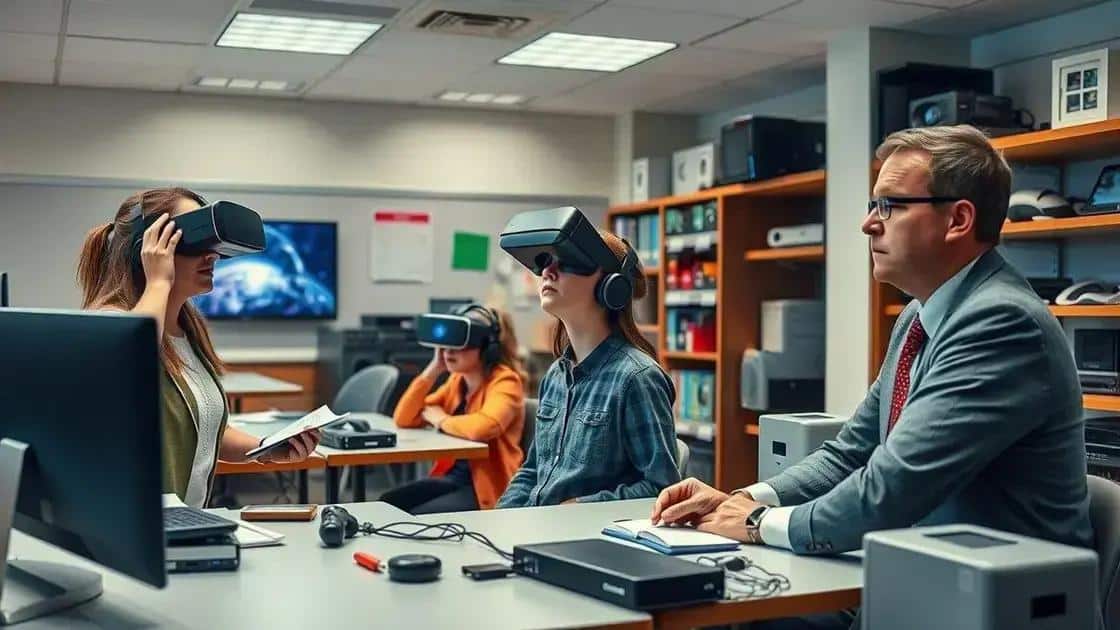
Implementing virtual reality in education comes with various challenges that schools must face. Understanding these obstacles is crucial to successfully adopt this innovative technology.
Cost Considerations
One of the main challenges is the cost associated with virtual reality tools. Purchasing VR headsets, software, and the necessary infrastructure can be expensive. Many schools struggle to find budgets for these advanced technologies, especially when competing with other educational needs.
Technical Issues
Technical problems can also arise during implementation. Schools may face difficulties in integrating VR systems with existing technologies. Regular maintenance and updates are needed to keep the systems running smoothly. These ongoing technical demands can be daunting for educators who may not have the necessary training.
- Incompatibility with current systems can lead to frustration.
- Limited tech support can make issues harder to solve.
- Familiarization with VR software requires additional training.
Another hurdle is the need for teacher training. Educators must feel comfortable using virtual reality tools in their teaching. Without proper training, they may not effectively leverage the technology to enhance learning experiences.
Furthermore, there is the concern of content creation. Creating high-quality, age-appropriate content for VR experiences can be time-consuming and resource-intensive. Not all subjects have readily available VR material, so teachers might have to develop their own, which can be a daunting task.
Lastly, some students may experience motion sickness or discomfort while using VR headsets. Schools need to be aware of these potential health issues and find ways to address them. This can affect how frequently virtual reality can be used in a classroom setting.
Case studies of successful virtual reality programs
Several schools and organizations have successfully implemented virtual reality programs that showcase its benefits. These case studies highlight real-world applications and how they enhance learning.
Stanford University
At Stanford University, VR is used in medical training. Students practice surgical skills in a simulated environment, allowing them to make mistakes without the risk of harming real patients. This hands-on experience significantly boosts their confidence before they step into actual operating rooms.
University of Maryland
The University of Maryland has integrated virtual reality into its environmental science curriculum. Students explore ecosystems virtually, studying climate change effects without leaving the classroom. This immersive way of learning helps students understand complex environmental issues more deeply.
- Enhanced engagement through realistic simulations.
- Allows exploration of hard-to-reach or dangerous locations.
- Improved retention of information due to experiential learning.
Another exemplary case is the use of VR at the University of Illinois. Here, students in history classes can participate in a virtual tour of historical landmarks. By walking through ancient structures, they gain insights that textbooks alone cannot provide.
Moreover, schools like the New Jersey Institute of Technology have adopted VR for architecture and design programs. Students create and walk through their designs, making real-time adjustments and experiencing their creations in a virtual space. This ability directly impacts their creativity and design skills.
These case studies demonstrate how virtual reality helps enhance education. Schools and universities can transform traditional learning by adopting such innovative technologies, providing students with unique experiences that benefit their academic journey.
The future of education with virtual reality
The future of education with virtual reality looks bright, promising innovative changes in how students learn. With advancements in technology, classrooms are evolving into immersive learning experiences.
Expanding Accessibility
One significant change is increased accessibility. Virtual reality allows students from various backgrounds to learn together without physical limitations. Students in remote areas can access high-quality resources and participate in virtual classrooms, creating equal opportunities for all.
Personalized Learning Experiences
The future will also bring more personalized learning paths. With VR technology, educators can tailor lessons to fit individual student needs. This customization means learners can move at their own pace and focus on topics that interest them, enhancing overall engagement.
- Students can explore subjects that align with their career goals.
- Gamification elements will make learning more fun and relevant.
- Immediate feedback can help improve understanding and retention.
Additionally, as virtual reality resources continue to grow, educators will have access to a vast library of simulations and environments. This means teachers can bring history, science, and art to life in ways previously thought impossible.
Another emerging trend is the use of virtual reality for skills training in various professions. From healthcare to engineering, VR can provide realistic simulations that prepare students for real-world challenges.
Moreover, virtual reality has the potential to enhance social interaction among students. By participating in team-based activities and projects in a virtual space, students can develop essential communication and collaboration skills.
As we look ahead, the integration of virtual reality into education will likely shape a new generation of learners. These students will be more prepared for the future workplace, equipped with both knowledge and practical experience from their immersive educational journeys.
FAQ – Frequently Asked Questions about Virtual Reality in Education
How does virtual reality enhance student engagement?
Virtual reality creates immersive experiences that capture students’ attention, making learning more enjoyable and effective.
Can virtual reality accommodate different learning styles?
Yes, VR caters to various learning styles, allowing visual and kinesthetic learners to engage with material in a way that suits them.
What are some challenges in implementing virtual reality in classrooms?
Challenges include high costs, technical issues, and the need for teacher training to use the technology effectively.
How can virtual reality prepare students for their future careers?
VR offers realistic training experiences that help students develop vital skills needed in the workforce, making them more competitive.

